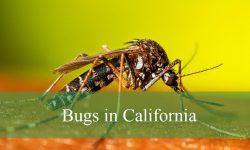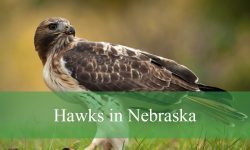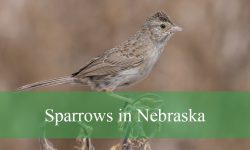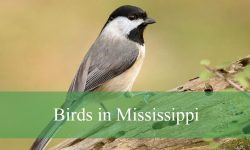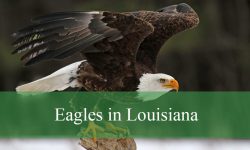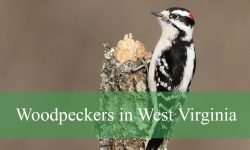Washington is home to a diverse array of spiders, each contributing to the rich tapestry of its ecosystems. From the intricate orb weavers like the Nordmann’s Orbweaver to the stealthy Woodlouse Spider, these arachnids display unique characteristics.
Let’s explore the fascinating world of spiders in Washington, where nature unfolds its myriad wonders through the article below.
Different Types of Spiders in Washington
California Flattened Jumping Spider
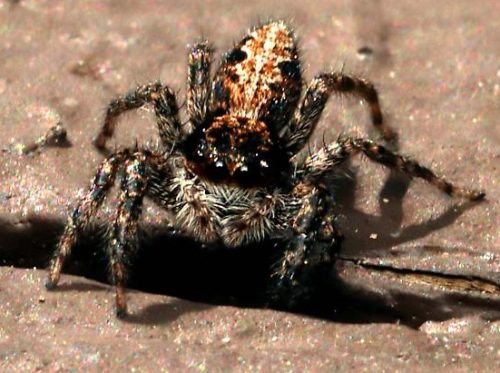
The California Flattened Jumping Spider, or Platycryptus californicus, is a member of the Salticidae family. Known for their remarkable leaping prowess in relation to their size, these black-colored spiders have brown and white patterns on their cephalothorax and mostly white patterns on their lengthy, hairy abdomens. There is black, brown, and white banding on the legs. Making use of their quickness, they leap great distances to ambush their victim. They hunt during the day and withdraw to their hiding places at night using webs as retreats.
Sierra Dome Spider
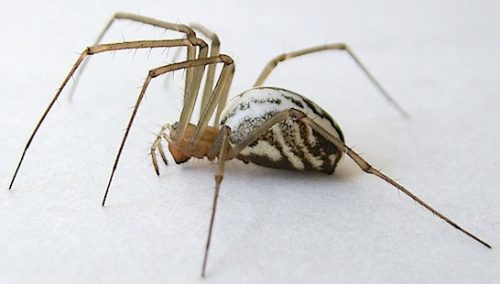
Known by most as the Sierra Dome Spider, Neriene litigiosa weaves webs that resemble domes and hangs them between wood edges and shrubs. Under the domes, females turn over and frequently mate with several men. Males actively seek mates, waiting on branches or the edge of the web, but females hardly leave their webs. These are outdoor spiders, and encounters with them usually take place with the spider inside its web.
Johnson’s Jumping Spider
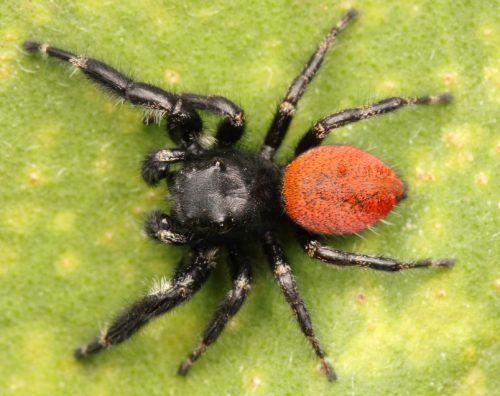
Phidippus johnsoni is a small arachnid that can jump more than five times its body length. It is sometimes referred to as the Johnson’s Jumping Spider or the Red-backed Jumping Spider. They rely on ambushing victims with quick jumps and injecting venom after biting, in contrast to web-spinners. These spiders hide, eat, and store food inside the webs they have made. They are known to bite, but they are not dangerous, and they are active during the day.
Common House Spider
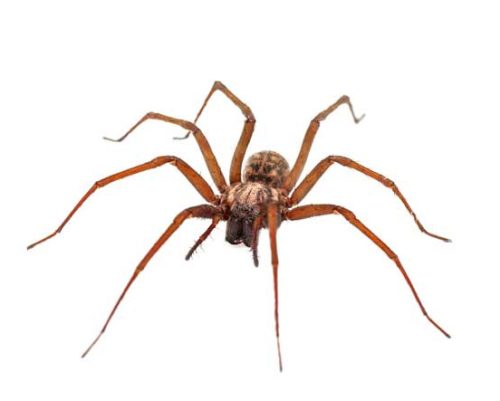
The Parasteatoda tepidariorum, also referred to as the American House Spider or Common House Spider, is well-known for weaving Halloween-themed webs in attics and windows. Weavers of webs frequently construct them close to one another. The lengthy legs of these comb-footed spiders contain hairs that resemble combs on the ankles. They use silk threads to entangle insects so they may bite them before eating them. They are made less noticeable by their brown, bulbous belly, which is speckled with white and has dark stripes. Though they can bite, they are not aggressive and usually pretend to be dead when threatened, thus they are not a serious threat to people.
Mouse Spider
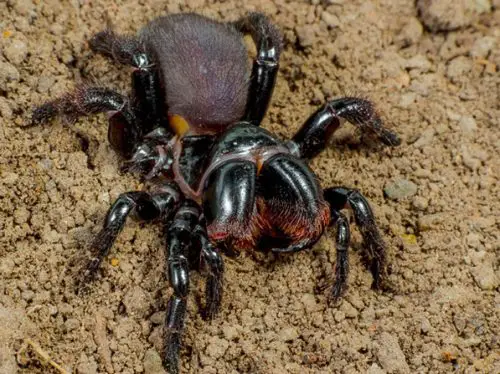
The Gnaphosidae family, which includes the Mouse Spider (scientifically named Scotophaeus blackwalli), was brought to North America from Europe. These spiders hide in wall cracks or beneath bark, and they are frequently encountered both indoors and outdoors. Males, who hunt at night, can grow up to 9 mm in length, while females can reach up to 12 mm. They have a start-and-stop movement that is distinctly mouse-like, and they have a dark brown carapace, a gray to brown abdomen, and hairs that resemble mice. Their look notwithstanding, they are not regarded as medically significant.
Long-Bodied Cellar Spider
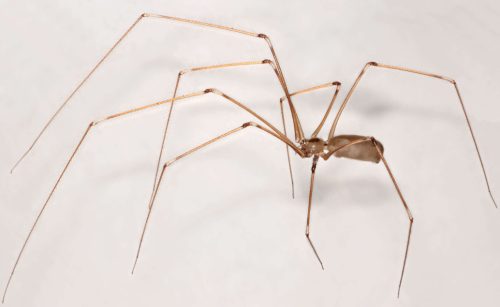
Pholcus phalangioides has spindly legs and an extended, tubular belly. It is often referred to as the Daddy Long-Legs Spider or the Long-Bodied Cellar Spider. It hangs upside down in its web, nearly blind, waiting for trapped insects. It is harmless to humans because of its small mouthparts. It gives the impression of being blurry and is well-known for bouncing in webs, which may help entangle animals and discourage predators.
Common Candy-Striped Spider
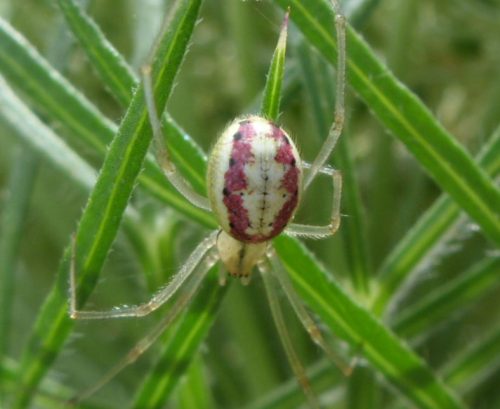
Originally from Europe, Enoplognatha ovata, also called the Common Candy-Striped Spider, is a member of the Theridiidae family and was brought to North America. It has translucent legs with a leg span of up to 6 mm and a bulbous, multicolored belly. These tiny, adept predators, which can be found in hedgerows, meadows, and gardens, are able to catch larger insects than they are. They are white, green, or cream in hue with black patches; they have one large red stripe or two red stripes arranged in a characteristic V pattern.
False Black Widow
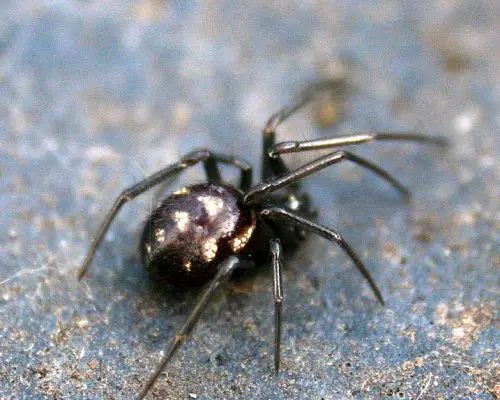
Steatoda grossa, often called the False Black Widow or Cupboard Spider, is a species of spider with dark, bulbous abdomens that reaches a maximum length of 10.5 mm in females. Their color varies from black with lighter patterns to purple-brown. Their belly markings are not as vivid as those of actual black widows. Males are more slender but have comparable coloring. Due of their limited vision, false black widows weave cobwebs out of sticky silk, detecting prey through vibrations. Although they are usually not aggressive, bites can happen when they get caught between clothes and the body. These bites can cause symptoms that linger for several days, such as blistering, pain, fever, muscular spasms, and sweating.
Bold Jumping Spider
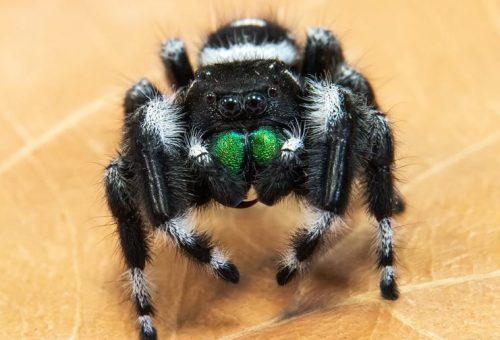
Phidippus audax is a member of the Salticidae family and is also referred to as the Bold Jumping Spider or the Daring Jumping Spider. These tiny spiders are incredibly adept at jumping long distances, which helps them avoid predators and ambush victims. They are difficult to capture, however they can bite, which stings but doesn’t really harm people. They have bright colors, with two white dots close to the back and a black and white line on the upper portion of their abdomens. They live in automobiles, offices, and other places, and they are mostly active during the day as they search for insects.
Goldenrod Crab Spider
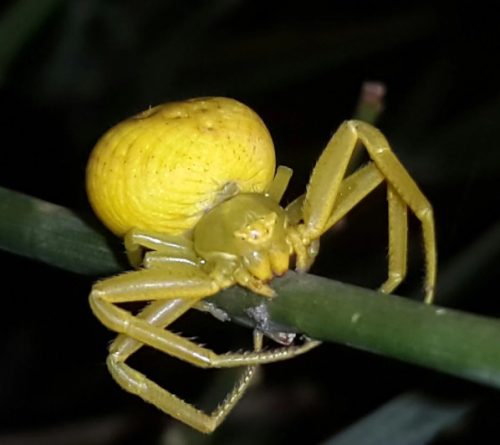
Misumena vatia, also referred to as the Flower (Crab) Spider or Goldenrod Crab Spider, is frequently observed hunting amidst milkweed plants and sprays of goldenrod. Walking like crabs in all directions, females grow up to a length of 0.39 inches (10mm), which is greater than the 0.20 inches (5mm) that males grow to. Some of them have a mixture of colors, ranging from white to yellow. By molting, these spiders can alter their color to better suit their environment. They exhibit a liking for particular flowers and feed on a variety of insects, even larger ones than themselves. Males usually travel in quest of mates, while females stay on a single flower.
Zebra Jumping Spider
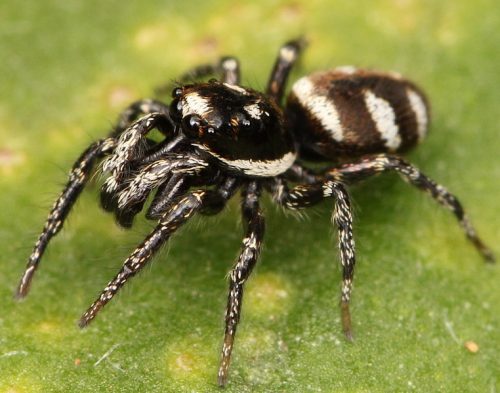
Salticus scenicus, commonly called the Zebra Jumping Spider, is a spring-to-fall-occurring spider with a maximum body length of 8 mm. Easily identified by their black and white markings, they can be seen hunting on outside walls and occasionally enter within in search of food. With their keen eyes, these ambush hunters prey on tiny insects during the day. Their webs are used as safe havens for ingesting trapped prey and as places to store eggs.
Giant House Spider
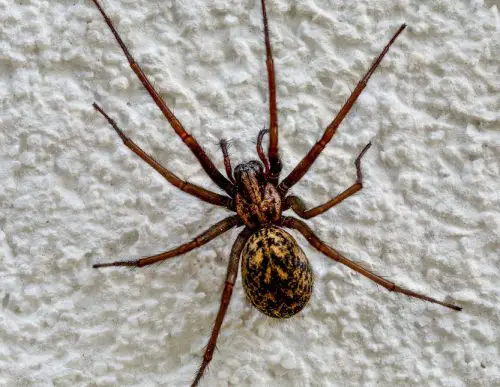
Large brown in color, Eratigena duellica, also known as the Giant House Spider, has light patterns on its sternum and three spots that create an arrow on its side. Their legs, abdomen, and hairy palpations are characteristic. With a varied leg span up to 2.95 inches (75mm), females reach 0.73 inches (18.5mm) in body length and males 0.59 inches (15mm). Their eight eyes, arranged in two equal rows, accentuate their predatory appearance. They wait patiently for prey, using a funnel to create flat, non-sticky webs. These webs are typically discovered in corners, behind furniture, and in basements—places where there is least chance of disturbance. Although their venom is meant to numb pain, bites, similar to bee stings, are treatable at home and do not require medical attention.
Cross Orbweaver
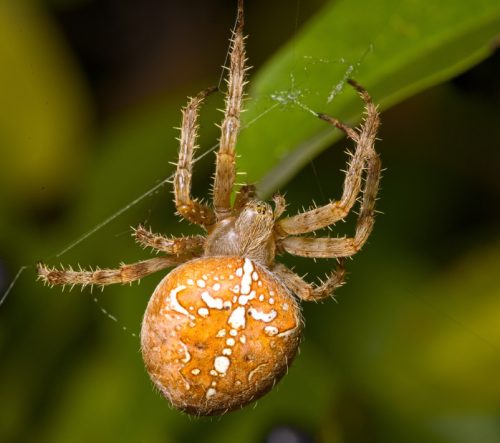
Originally from Europe, Araneus diadematus, sometimes known as the Cross Orbweaver, has adapted well to North America. Females are twice as large as males, and their dark brown abdomen is marked with a characteristic white cross. The spider lives upside down in a big, circular web. It has legs with bands of brown and tan color and white hairs on the cephalothorax. It conceals and falls to the ground when surprised. Numerous environments support cross orbweavers, including as gardens, meadows, grasslands, evergreen woods, semi-arid deserts, and woodlands.
Grey Cross Spider
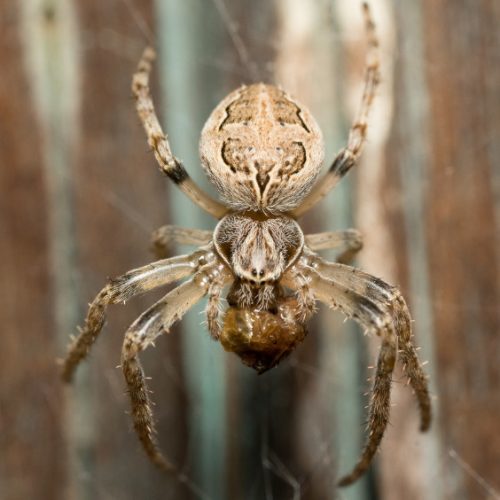
Sexual dimorphism is exhibited by Larinioides sclopetarius, also referred to as the Grey Cross Spider or Bridge Spider. Males are longer but lighter than females; they can develop to a maximum body length of 7mm, while females can weigh up to 60mg and reach a maximum body length of 6.25mm. They have a characteristic silhouette thanks to the dark marks on their abdomens and the white hairs on their heads. Females deliberately select lit regions for web-building and egg-laying; they are frequently observed close to artificial light sources that attract insects. Juveniles have fewer attractive eating places because they are still unable to effectively compete with larger adult females who dominate prime foraging spots.
Pacific Folding Door Spider

Male and female Antrodiaetus pacificus, also known as the Pacific Folding Door Spider, are members of the Mygalomorph spider species. The first descriptions of this species date back to 1884. With three abdominal patches adorning their dark brown to black carapace, females can grow up to 13mm in length, while males are slightly smaller at about 11mm. These spiders live in chilly, damp forests where they dig burrows in soft substrates like decaying wood, sand, and moss. They wait for passing beetles and other insects by opening their tunnel entrance at night. During the day, they keep it closed.
Nordmann’s Orbweaver
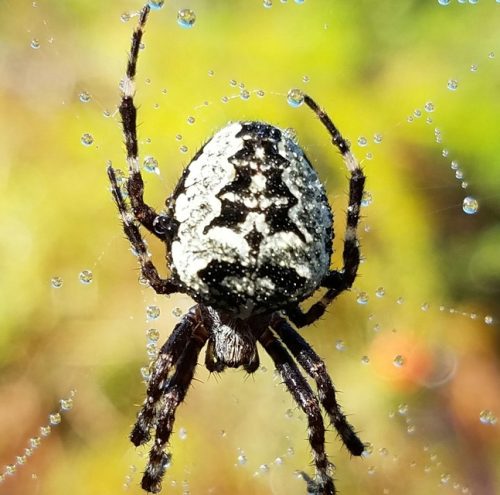
Araneus nordmanni, also referred to as Nordmann’s Orbweaver, is an orb-weaving spider that belongs to the Araneidae family. Its webs can typically measure up to two feet in diameter. At the center of her web, the female assumes an upside-down stance and waits for her prey to become entangled. These webs are frequently seen in meadows, woodlands, gardens, backyards, and grasslands.
Hobo Spider
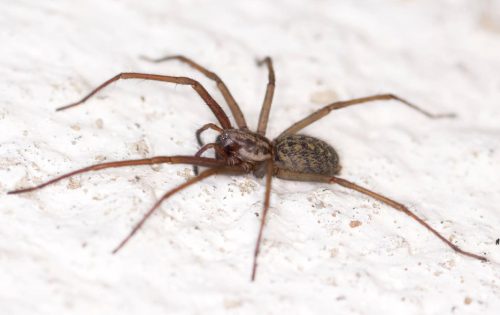
The Hobo Spider, or Eratigena agrestis, is a type of funnel-web spider that is distinguished by its ability to weave webs with a funnel form. At the end of the funnel, these spiders wait for insects to entangle themselves in them. It is known that hobo spiders weave their webs both inside and outside of houses. They are brown, up to 14 mm in length, and have a chevron pattern in the middle of their abdomen that points in the direction of the head. A thin stripe also runs along the middle of the sternum.
Cat-Faced Orbweaver
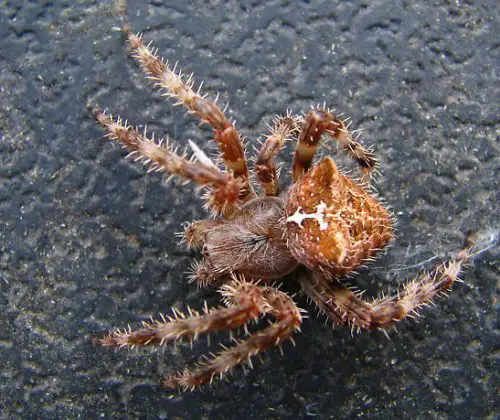
Araneus gemmoides, often known as the Jewel Spider or Cat-Faced Spider, is a common outdoor spider that is not dangerous to people. These spiders, sometimes called jewel spiders, weave webs on the walls of buildings adjacent to enclosed areas and artificial light sources. They are also found beneath wood and under overhangs. These colorful, multicolored spiders change color from winter to summer. They have two horn-shaped extensions on their abdomen.
Western Spotted Orbweaver
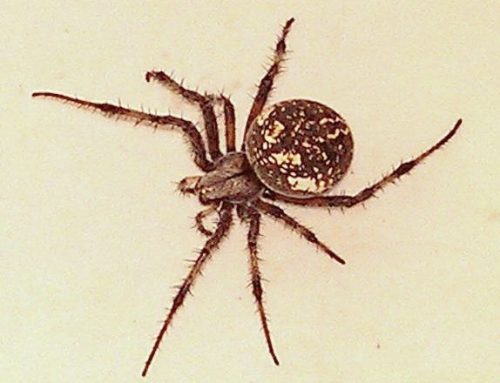
The Western Spotted Orbweaver, or Neoscona oaxacensis, is a large spider that reaches a length of 18 mm for females and 13 mm for males. Their abdomen has a characteristic pattern of black and white. They live in a variety of places, such as yards, parks, and low-lying forests. When disturbed in their web, they vibrate, much like the long-bodied cellar spider. They usually fall from the center of the web and seek shelter until the perceived threat has passed, posing no harm to people.
Eurasian Running Crab Spider
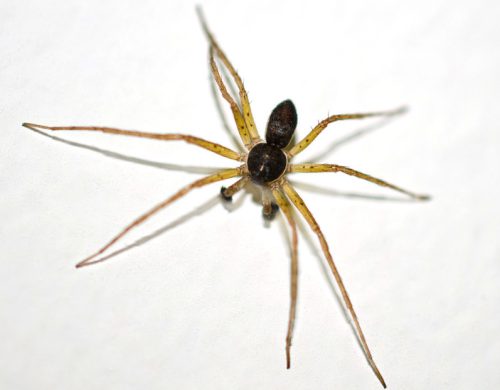
The Eurasian Running Crab Spider, or Philodromus dispar, is commonly found among trees and shrubs. Swift predators, females vary in size and color, while males are shiny, black or dark brown with white edges, and can grow up to 5 mm in length. Their primary food sources are flies and small insects, and they hunt similarly to cats by staying still and ambushing their prey as it gets close.
Northern Yellow Sac Spider
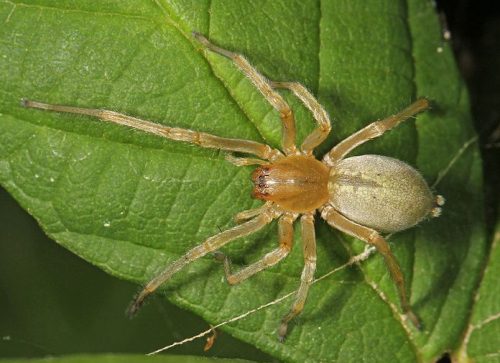
Known by most as the Northern Yellow Sac Spider, Cheiracanthium mildei is a green or tan colored spider with dark brown palpi and chelicerae. Its body length reaches approximately 0.4 inches (10mm). They were brought to the US and are frequently found both outside and indoors. With venom, their bites usually result in eight hours of localized symptoms, which begin as a mosquito bite-like mark and can progressively worsen into agonizing swelling and ulceration up to 10 cm. The need for medical intervention may arise, and recovery may take several weeks or months.
Western Black Widow
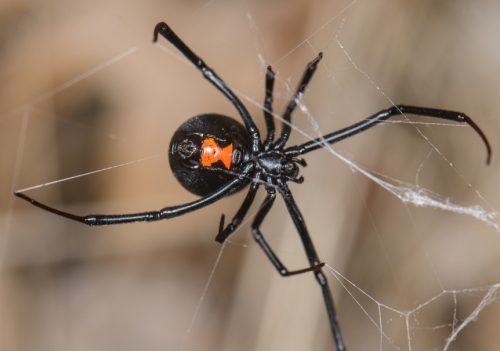
The Western Black Widow, or Latrodectus hesperus, is a poisonous spider species. Females can reach a maximum size of 16 mm. Females are black with a red hourglass-shaped pattern on their bellies and possess a strong neurotoxic venom. Males are tan and smaller. They weave tangled webs. Notably, no deaths from Western black widow bites have been reported in North America, despite fatalities from these bites ranging from 0.5% to 12% globally. Pain, goosebumps, perspiration, and discomfort are some of the symptoms.
Silver-Sided Sector Spider
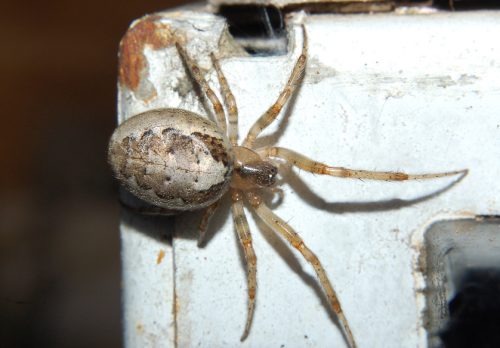
Sexual dimorphism is exhibited by Zygiella x-notata, also referred to as the Missing Sector Orb Weaver or Silver-Sided Sector Spider. Males can reach a body length of 7mm, while females can only reach 1mm. The females have dark gray waves on the underside, gray banding on their legs, and a silver sheen on their abdomens. Males are smaller than females, with darker undersides, legs, and a cephalothorax that is brown in color. Their abdomens are also cream in color. From July to October, these spiders are more common.
Grass Spiders

The funnel weaver family includes the American Grass Spider, sometimes referred to as the Grass Spider. They avoid sticky webs in favor of creating sheet webs with funnel shelters, which are known for their ability to catch insects quickly. These spiders have eight eyes organized in three rows and can grow up to be 19 mm in length. Their legs stand out for their unique banding, which is enhanced by two black bands that extend along their cephalothorax’s sides.
Banded Garden Spider
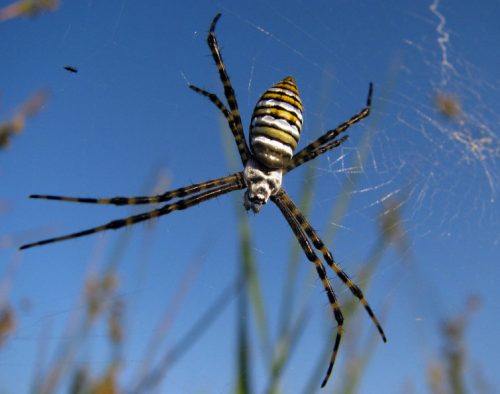
Argiope trifasciata is a member of the orb weaver family and is also known as the Banded Garden Spider or the Banded Orb Weaving Spider. They are well-known for making circular webs that may reach up to two feet in length, and larger adults can reach up to two meters. While smaller guys weave neighboring webs, females arrange themselves upside down in a cross form at the middle of the web. These spiders use biting, venom injection, and covering their prey in silk to catch and consume insects bigger than themselves.
Woodlouse Spider
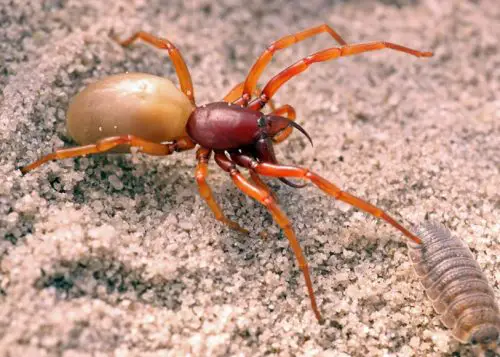
Male Dysdera crocata spiders are smaller, measuring around 10mm, while females can grow to a maximum length of 15mm. This species is also referred to as the Slater Spider, Woodlouse Hunter, Sowbug Hunter, and Sowbug Killer. These spiders have a bright yellow, brown, or beige abdomen combined with orange or dark red legs and a cephalothorax. They are usually found around houses, where they live behind logs, rocks, bricks, and leaf litter, close to the woodlice that are their main source of food. During the day, woodlouse spiders spend their time hiding in silken retreats, but at night, they go out hunting and spin webs to find food and cover.
Bronze Jumping Spider
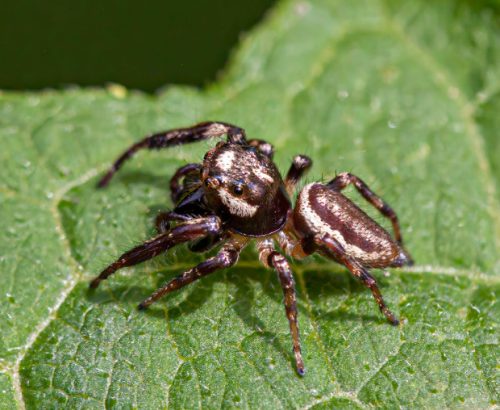
Eris militaris, commonly called the Bronze Jumper or Bronze Lake Jumper, is prevalent in Washington. Male bronze jumping spiders feature a dark cephalothorax with white side banding and a lighter-colored abdomen with white bands. Females exhibit a lighter cephalothorax and a darker abdomen without white bands. Females can grow up to 8mm, while males reach 6.7mm. Found in homes, fields, and woods, their bronze brown coloration aids camouflage. Though capable of biting when provoked, they are generally more curious than aggressive, often opting to run and hide when they sense a threat.
People Who Read This Also Read:

